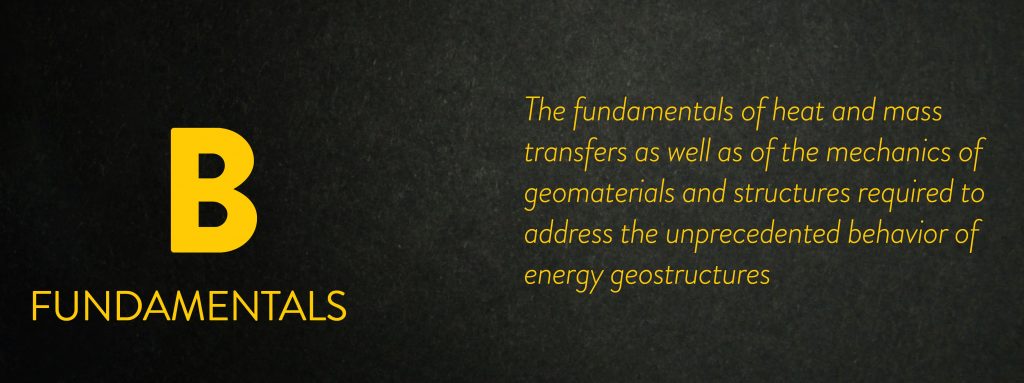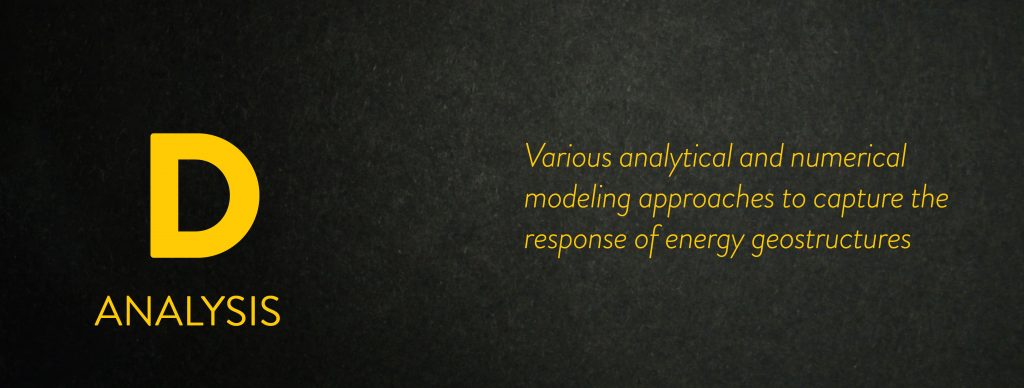Abstracts


This chapter is an introduction to the world’s anthropogenic development, energy question and environmental pollution, highlighting the importance of resorting to energy sources and technologies that can sustain human activity needs with a limited impact on the environment. Geothermal energy is described with particular attention compared to other energy sources due to its unique features for addressing the previous challenge, and aspects of geotechnologies that allow the harvesting of the considered energy source are expanded. The considered subjects are treated with the ultimate purpose of providing, together with Chapter 2, Energy geostructures, a framework for understanding the relevance, rationale and features of the energy geostructure technology.
This chapter presents the technology of energy geostructures as a breakthrough means for the renewable energy supply and the structural support of built environments. The use and capabilities of energy geostructures in the context of both ground source heat pump systems and underground thermal energy storage systems are addressed, and factors that can be used to characterise the considered technology from the perspective of its energy transfer effectiveness are proposed. Examples of energy geostructure applications worldwide are presented with particular reference to noteworthy projects and an overview of the phenomena governing this technology is eventually proposed.

This chapter presents a theoretical treatment of heat and mass transfers in the context of energy geostructures. The relevance of heat and mass transfers is highlighted with respect to their role in the characterisation of the thermohydraulic behaviour of materials, and thus of energy geostructures, through the flow of thermal energy and fluid volumes. The developments treated in this chapter prepare for the analysis of deformation phenomena under nonisothermal conditions that is addressed in Chapter 4, Deformation in the context of energy geostructures, as well as for the understanding of various aspects addressed in Parts C, D and E of this book.
This chapter presents a theoretical treatment of deformation phenomena that can occur under nonisothermal conditions associated with heat transfer processes in the context of energy geostructures. The relevance of deformation under nonisothermal conditions is highlighted with respect to its role in the characterisation of the reversible and irreversible thermomechanical behaviour of materials, and thus of energy geostructures. A framework resorting to the essentials of the theories of thermoelasticity, plasticity and thermoplasticity is proposed to understand, model and predict deformation phenomena, and key features of such theories are expanded for the considered aims. This chapter complements the knowledge treated in Chapter 3, Heat and mass transfers in the context of energy geostructures, and serves as a basis for various developments proposed in Parts C–E of this book.

This chapter focuses on the experimental analysis of the thermohydromechanical behaviour of soils and soil–structure interfaces based on the results of laboratory tests. The behaviour of soils as well as soil–structure interfaces is expanded with a focus on their deformation and strength under nonisothermal conditions. The influence of aspects that govern such behaviour are highlighted. The developments proposed in this chapter serve as a basis for the treatment of the response of energy geostructures to mechanical and thermal loads discussed in Chapter 6, Thermo-mechanical behaviour of single energy piles, and Chapter 7, Thermo-mechanical behaviour of energy pile groups, as well as for the content of the Parts C, D and E of this book.
This chapter focuses on the experimental analysis of the response of single energy piles to the mechanical and thermal loads associated with the coupled structural support and heat exchanger role of such foundations based on the results of full-scale in situ tests. The analysis expands on the temperature, strain, displacement and stress variations characterising single energy piles and highlights aspects of crucial importance for the comprehensive analysis of the thermomechanical behaviour of such geostructures. The developments presented in this chapter serve as a basis for the treatment of the response of energy pile groups to mechanical and thermal loads discussed in Chapter 7, Thermomechanical behaviour of energy pile groups.
This chapter focuses on the experimental analysis of the response of energy pile groups to the mechanical and thermal loads associated with the coupled structural support and heat exchanger role of such foundations based on the results of full-scale in situ tests. The analysis expands on the temperature, strain and stress variations characterising energy pile groups and highlights aspects of crucial importance for the comprehensive analysis of the thermomechanical behaviour of such geostructures. The developments presented in this chapter complement the treatment of the response of single energy piles to mechanical and thermal loads discussed in Chapter 6, Thermomechanical behaviour of single energy piles.

This chapter focuses on the analysis of the heat and mass transfer phenomena characterising energy geostructures in a time-independent framework that is representative of steady conditions. Relevant reference time and space scales allowing the modelling of heat and mass transfers under the considered conditions are discussed, and the analytical analysis of heat and mass transfer phenomena within and around energy geostructures is presented via the consideration of the processes involved with the flow of a heat carrier fluid in pipes. The developments proposed in this chapter serve as a basis for the time-dependent analytical analysis of heat transfer that constitutes Chapter 9, Analytical modelling of transient heat transfer.
This chapter focuses on the analysis of the heat transfer phenomena characterising energy geostructures in a time-dependent framework that is representative of transient conditions. Analytical approaches to model heat transfer at both relatively long and short-to-medium timescales, around and within geothermal heat exchangers such as energy geostructures, respectively, are presented. The developments proposed in this chapter can characterise, together with the time-independent analytical solutions treated in Chapter 8, Analytical modelling of steady heat and mass transfers, many heat transfer problems involved with the operation of energy geostructures. Although more approximate than the numerical methods treated in Chapter 12, Numerical modelling of energy geostructures, the proposed analytical approaches can be considered powerful tools for the thermohydraulic analysis of energy geostructures.
This chapter focuses on the analysis of the capacity and deformation of single energy piles subjected to axial mechanical loads and thermal loads. Analytical approaches to model the failure of energy piles induced by axial mechanical loads are proposed, while semianalytical approaches to predict the axial deformation of such foundations subjected to thermal loads, applied alone or in conjunction with mechanical loads, are highlighted. The predictions resulting from the application of the discussed approaches are compared with full-scale in situ test results, and the capabilities of such methods are discussed. The developments proposed in this chapter serve as a basis for the analytical analysis of the capacity and deformation of energy pile groups that is addressed in Chapter 11, Analytical modelling of capacity and deformation of energy pile groups.
This chapter focuses on the analysis of the capacity and deformation of energy pile groups subjected to axial mechanical loads and thermal loads. Analytical and semianalytical approaches to model both the failure of energy piles induced by axial mechanical loads and the deformation of such foundations caused by axial mechanical loads and thermal loads are proposed. The predictions resulting from the application of the discussed approaches are compared with more rigorous numerical results as well as with full scale in situ test results, and the capabilities of such methods are discussed. The developments presented in this chapter complement the analytical solutions discussed in Chapter 10, Analytical modelling of capacity and deformation of single energy piles, for single energy piles and may be employed to predict the actual response of such foundations described in Chapters 6, Thermomechanical behaviour of single energy piles and Chapter 7, Thermomechanical behaviour of energy pile groups.
This chapter focuses on the numerical modelling of the thermohydromechanical behaviour of energy geostructures for typical technical solutions and site conditions that can characterise such applications. The previous factors include, without being limited to (1) the pipe configuration, (2) the geostructure geometry, (3) the heat carrier fluid flow rate circulating in the pipes, (4) the soil–geostructure thermal expansion coefficient ratio and (5) the soil–geostructure thermal conductivity ratio. Comments on the capability of numerical simulations to capture observed responses of energy geostructures are highlighted and remarks of practical significance are summarised. The developments presented in this chapter allow achieving advanced information on the multiphysical response of energy geostructures in many of the situations that are likely to be encountered in practice.

This chapter presents the theoretical essentials constituting the so-called performance-based design of structures, with a focus on novel aspects and practical approaches that can address the geotechnical and structural performance of energy geostructures. The analysis is developed in the framework of European Norms often called the Eurocodes, but it may be extended to other representative normative frameworks. The developments presented in this chapter resort to the knowledge and the analysis approaches treated in Parts B, C and D of this book, and serve as a basis for the complementary considerations and examples about the performance-based design of energy geostructures discussed in Chapter 14, Determination of design parameters for energy geostructures and Chapter 15, Performance-based design of energy piles.
This chapter addresses the parameters required for the design of energy geostructures, with a focus on their determination through experimental approaches. The analysis highlights categories of parameters whose determination should be addressed depending on whether the energy, geotechnical or structural design of energy geostructures is considered. Testing approaches allowing the determination of parameters that serve the previous designs are highlighted, and testing recommendations are proposed. The developments presented in this chapter complement the knowledge treated in Chapter 13, Performance-based design in the context of energy geostructures, and serve as a basis for the performance-based design of energy geostructures discussed in Chapter 15, Performance-based design of energy piles.
This chapter focuses on the performance-based design of energy piles subjected to axial mechanical loads and thermal loads. A general design methodology to verify the geotechnical and structural performance of energy piles against the influence of thermal and mechanical loads is proposed, and design criteria and approaches that may be considered for this aim are expanded. The previous subjects are addressed with reference to the Eurocodes, but they may be extended to other performance-based standards and frameworks via potential modifications. The developments presented in this chapter resort to the knowledge treated in Part D of this book, complement the design considerations discussed in Chapter 13, Performance-based design in the context of energy geostructures, and Chapter 14, Determination of design parameters for energy geostructures, and allow developing the performance-based design of energy piles in many of the situations that are likely to be encountered in practice.
This chapter focuses on the design of details unprecedentedly characterising energy geostructures, in contrast to conventional geostructures, which are required for the expedient yet effective application of this technology as well as for their optimal operation and performance. Attention is given in this framework to the design of the features that may preferably be employed for the piping network installed within and between energy geostructures. In the treatment of these aspects, reference is made to recommendations available at the national level in Switzerland, United Kingdom and France as well as to practical experience in this scope. The developments presented in this chapter complement the design considerations discussed in Chapters 13–15 and may be considered from the analysis to the design and construction phases of energy geostructures.
